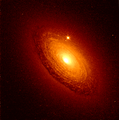NGC 1161 is a lenticular galaxy approximately 90 million light-years away from Earth in the constellation of Perseus.[3] It was discovered, along with NGC 1160, by English astronomer William Herschel on October 7, 1784.[4]
NGC 1161 is classified as a Type 1.9 Seyfert galaxy.[5] It forms a visual pair with the galaxy NGC 1160. Both galaxies are located between the Local and Perseus superclusters in the Perseus Cloud close to the centre of the Local Void.[6]
Image gallery
-
NGC 1161 (NASA/ESA HST)
-
NGC 1161 (NASA/ESA HST)
-
NGC 1161 by 2MASS
See also
References
- ^ a b c d e f "NASA/IPAC Extragalactic Database". ned.ipac.caltech.edu. Retrieved March 3, 2019.
- ^ a b "Revised NGC Data for NGC 1161". spider.seds.org. Retrieved March 3, 2019.
- ^ "NGC 1161". Retrieved March 3, 2019.
- ^ "Data for NGC 1161". www.astronomy-mall.com. Retrieved March 3, 2019.
- ^ Filho, Mercedes E.; Barthel, Peter D.; Ho, Luis C. (2006). "A Radio Census of Nuclear Activity in Nearby Galaxies". Astronomy & Astrophysics. 451 (1): 12. arXiv:astro-ph/0601080. Bibcode:2006A&A...451...71F. doi:10.1051/0004-6361:20054510. S2CID 16640767.
- ^ Gregory, Stephen A.; Thompson, Laird A.; Tifft, William G. (1981). "The Perseus Superclaster". The Astrophysical Journal. 243: 416. Bibcode:1981ApJ...243..411G. doi:10.1086/158608.
External links
- NGC 1161 on WikiSky: DSS2, SDSS, GALEX, IRAS, Hydrogen α, X-Ray, Astrophoto, Sky Map, Articles and images
- SEDS
















You must be logged in to post a comment.